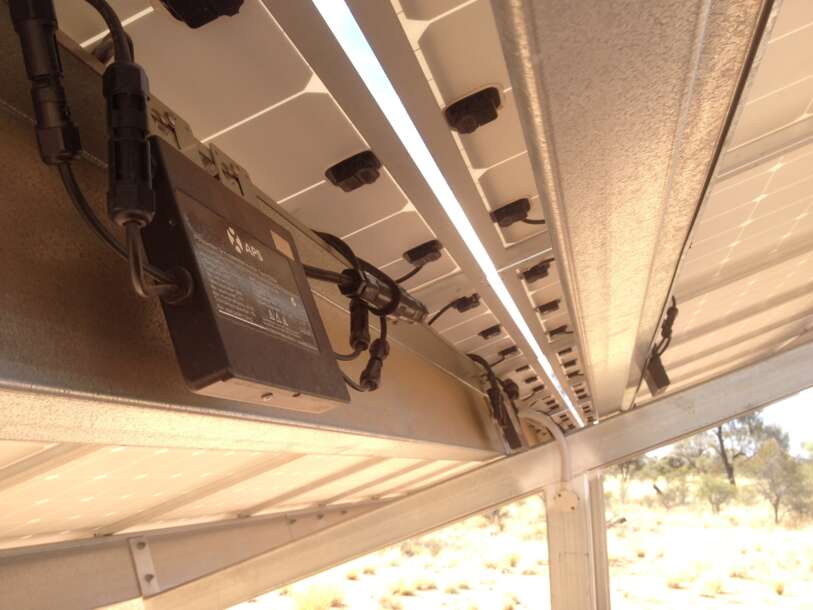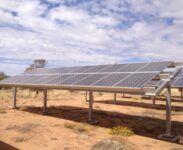| Manufacturer | TDG |
|---|---|
| Array Rating | 5kW |
| PV Technology | mono-Si |
| Array Structure | Fixed: Ground Mount |
| Installed | 2013 |
View on Map Graphs Download Data
Current Output

TDG Monocrystalline silicon array, fixed ground-mount.
TDG AC module: TDG 250W Monocrystalline module integrated with YC500 micro-inverter supplied by APS which is a global leading micro-inverter manufacturer invested by TDG.
TDG AC modules are easy to install, in this simplified system, installers just need to plug TDG AC modules together with provided connectors, rather than wiring lots of DC cables to connect the system.
Each TDG AC module has an individual MPPT which means each AC module produces its maximum power. For the same system size, it is believed that energy generated by an AC system is significantly more than a DC system. TDG AC module requires lower minimum power to start up, it has a better response to low light environment, especially in cloudy day and morning & evening.
In addition, as power output of each AC module is ready-to-use Alternate Current, and is connected in parallel, so there is no high DC voltage in this whole system, which enhances the system’s safety.
TDG, founded in 1984, listed in 2001, is a multinational, diversified industrial group with over 10,000 employees globally. Proudly being a pioneer to introduce AC module to Australia, we are now here to help building a better tomorrow for Australian.
The above technology description has been supplied by the manufacturer. The Desert Knowledge Australia Solar Centre is pleased to provide a platform for information sharing while not endorsing specific claims made about technologies installed at the site.
| Array Rating | 5kW |
|---|---|
| Panel Rating | 250W |
| Number Of Panels | 20 |
| Panel Type | TDG T250M606 |
| Array Area | 33.5 m2 |
| Type Of Tracker | N/A |
| Inverter Size / Type | APS Micro-inverter YC500 (x 10) |
| Installation Completed | Wed, 7 Aug 2013 |
| Array Tilt/Azimuth | Tilt = 20, Azi = 0 (Solar North) |

Notes on the Data
-
Metering failure
Circuit breaker supplying the metering equipment for sites 23-38 tripped off on Aug 19th and was discovered and turned back on on Aug 23rd. This resulted in a lack of generation data for these sites during this time but did not stop the sites from physically generating.
-
System Disconnection for Cabling Works
All arrays at the Solar Centre were disconnected from approximately 2.00pm to 3.00pm on Monday, 9 July 2018 in preparation for the cable between the main switchboard and distribution board being upgraded. Array sites #23-38 remained disconnected while the main feeder cable to these sites was replaced in subsequent days, but all systems were re-connected by early afternoon on Thursday, 12 July 2018.
-
System Outage at Australia Day Long Weekend
A breaker tripped at around 12.30pm on Friday, 26 January, likely due to high generation levels reached at this peak time on this high irradiance day. Connection was restored after the Australia Day long weekend at around 11.30am on Monday, 29 January but shortly tripped again.
UPDATE 26-02-2018. The cause of this reoccurring issue has been identified and will be rectified. The solution requires the upgrading of a key distribution cable. This should be completed in the coming months.
-
Connection Restored After Christmas/NY Period
Arrays have been re-connected following the outage that disconnected multiple sites from Christmas day 2017. The outage is believed to have been triggered by the tripping of two circuit breakers in separate distribution boards, making the diagnosis initially elusive. The ability of the common circuit shared by these arrays to keep abreast with increasingly high current demands as new arrays are installed and generation conditions are high is presently being addressed. For the same reason, intermittent outages persisted in the summer of early 2018.
-
System Outage at Christmas/NY Period
A system outage was caused by a circuit breaker trip at approximately 2pm on a high generation day shortly after installation of a new array at the DKA Solar Centre. The outage commenced on 25 December continuing into the new year and is being addressed.
-
System Outage for New Array Connection
Sites 23 through to 37 experienced an outage today from 11:10 to 11:50. The outage was due to the local distribution board being temporarily being taken offline to allow for the connection of a new PV system.
-
Monitoring Interruption for UPS Battery Replacement
The disconnection and re-connection of the solar arrays and weather station equipment while a new site connection was being established prompted the already flattening UPS batteries which power the site’s energy meters to fail and require immediate replacement. Data recording was affected from approximately 2.30pm ACST, Monday 10 July to 4.00pm, Wednesday 12 July.
Affects weather data for DKASC, Alice Springs
-
Site 31: Hot Spots
A recent annual maintenance inspection observed hot spots on two solar modules: the third module from the east in the bottom row and the second module from the west in the top row.
-
Partial System Outage
One of the major switchboards at the DKASC lost power yesterday 01/12/2016 at ~11:00 am. This isolated and shutdown array sites 23 through to 37 inclusive. The switchboard was re-energised at ~16:30 today (02/12/2016) and is again operating normally. Data for this period for these sites is lost.
> Answer to Spotlight Question
Onsite at the DKA Solar Centre in Alice Springs are a series of quiz-like Spotlight Questions at each array. Visit the centre and scan the QR code at each sign to test your knowledge – and check your answer here!
Q: What's the difference between an AC solar module, and a DC solar module that is simply connected to a microinverter to give AC electricity?
A: Effectively, there is no difference between a DC solar module that is connected to a microinverter, and those modules branded (sold) as AC modules. An AC module is a product that includes a DC module and microinverter packaged together. In both cases, sunlight is used to generate a DC current and produce a net output that is AC.

